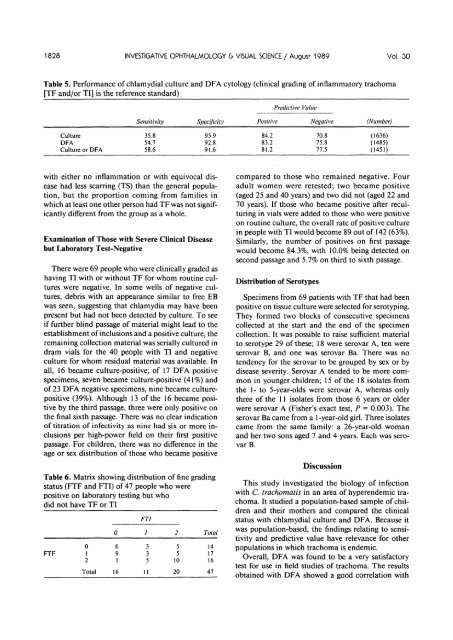The Epidemiology of Infection in Trachoma - Investigative ...
The Epidemiology of Infection in Trachoma - Investigative ...
The Epidemiology of Infection in Trachoma - Investigative ...
Create successful ePaper yourself
Turn your PDF publications into a flip-book with our unique Google optimized e-Paper software.
1828 INVESTIGATIVE OPHTHALMOLOGY & VISUAL SCIENCE / August 1989 Vol. 30<br />
Table 5. Performance<br />
[TF and/or TI] is the<br />
<strong>of</strong> chlamydial culture and DFA cytology (cl<strong>in</strong>ical grad<strong>in</strong>g <strong>of</strong> <strong>in</strong>flammatory trachoma<br />
reference standard)<br />
Predictive Value<br />
Sensitivity<br />
Specificity<br />
Positive<br />
Negative<br />
(Number)<br />
Culture<br />
DFA<br />
Culture or DFA<br />
35.8<br />
54.7<br />
58.6<br />
95.9<br />
92.8<br />
91.6<br />
84.2<br />
83.2<br />
81.2<br />
70.8<br />
75.8<br />
77.5<br />
(1636)<br />
(1485)<br />
(1451)<br />
with either no <strong>in</strong>flammation or with equivocal disease<br />
had less scarr<strong>in</strong>g (TS) than the general population,<br />
but the proportion com<strong>in</strong>g from families <strong>in</strong><br />
which at least one other person had TF was not significantly<br />
different from the group as a whole.<br />
Exam<strong>in</strong>ation <strong>of</strong> Those with Severe Cl<strong>in</strong>ical Disease<br />
but Laboratory Test-Negative<br />
<strong>The</strong>re were 69 people who were cl<strong>in</strong>ically graded as<br />
hav<strong>in</strong>g TI with or without TF for whom rout<strong>in</strong>e cultures<br />
were negative. In some wells <strong>of</strong> negative cultures,<br />
debris with an appearance similar to free EB<br />
was seen, suggest<strong>in</strong>g that chlamydia may have been<br />
present but had not been detected by culture. To see<br />
if further bl<strong>in</strong>d passage <strong>of</strong> material might lead to the<br />
establishment <strong>of</strong> <strong>in</strong>clusions and a positive culture, the<br />
rema<strong>in</strong><strong>in</strong>g collection material was serially cultured <strong>in</strong><br />
dram vials for the 40 people with TI and negative<br />
culture for whom residual material was available. In<br />
all, 16 became culture-positive; <strong>of</strong> 17 DFA positive<br />
specimens, seven became culture-positive (41%) and<br />
<strong>of</strong> 23 DFA negative specimens, n<strong>in</strong>e became culturepositive<br />
(39%). Although 13 <strong>of</strong> the 16 became positive<br />
by the third passage, three were only positive on<br />
the f<strong>in</strong>al sixth passage. <strong>The</strong>re was no clear <strong>in</strong>dication<br />
<strong>of</strong> titration <strong>of</strong> <strong>in</strong>fectivity as n<strong>in</strong>e had six or more <strong>in</strong>clusions<br />
per high-power field on their first positive<br />
passage. For children, there was no difference <strong>in</strong> the<br />
age or sex distribution <strong>of</strong> those who became positive<br />
Table 6. Matrix show<strong>in</strong>g distribution <strong>of</strong> f<strong>in</strong>e grad<strong>in</strong>g<br />
status (FTF and FTI) <strong>of</strong> 47 people who were<br />
positive on laboratory test<strong>in</strong>g but who<br />
did not have TF or TI<br />
FTF<br />
0<br />
12<br />
Total<br />
0<br />
6<br />
91<br />
16<br />
FTI<br />
1<br />
3<br />
3<br />
5<br />
11<br />
2<br />
5<br />
5<br />
10<br />
20<br />
Total<br />
14<br />
17<br />
16<br />
47<br />
compared to those who rema<strong>in</strong>ed negative. Four<br />
adult women were retested; two became positive<br />
(aged 25 and 40 years) and two did not (aged 22 and<br />
70 years). If those who became positive after recultur<strong>in</strong>g<br />
<strong>in</strong> vials were added to those who were positive<br />
on rout<strong>in</strong>e culture, the overall rate <strong>of</strong> positive culture<br />
<strong>in</strong> people with TI would become 89 out <strong>of</strong> 142 (63%).<br />
Similarly, the number <strong>of</strong> positives on first passage<br />
would become 84.3%, with 10.0% be<strong>in</strong>g detected on<br />
second passage and 5.7% on third to sixth passage.<br />
Distribution <strong>of</strong> Serotypes<br />
Specimens from 69 patients with TF that had been<br />
positive on tissue culture were selected for serotyp<strong>in</strong>g.<br />
<strong>The</strong>y formed two blocks <strong>of</strong> consecutive specimens<br />
collected at the start and the end <strong>of</strong> the specimen<br />
collection. It was possible to raise sufficient material<br />
to serotype 29 <strong>of</strong> these; 18 were serovar A, ten were<br />
serovar B, and one was serovar Ba. <strong>The</strong>re was no<br />
tendency for the serovar to be grouped by sex or by<br />
disease severity. Serovar A tended to be more common<br />
<strong>in</strong> younger children; 15 <strong>of</strong> the 18 isolates from<br />
the 1- to 5-year-olds were serovar A, whereas only<br />
three <strong>of</strong> the 11 isolates from those 6 years or older<br />
were serovar A (Fisher's exact test, P = 0.003). <strong>The</strong><br />
serovar Ba came from a 1-year-old girl. Three isolates<br />
came from the same family: a 26-year-old woman<br />
and her two sons aged 7 and 4 years. Each was serovar<br />
B.<br />
Discussion<br />
This study <strong>in</strong>vestigated the biology <strong>of</strong> <strong>in</strong>fection<br />
with C. trachomatis <strong>in</strong> an area <strong>of</strong> hyperendemic trachoma.<br />
It studied a population-based sample <strong>of</strong> children<br />
and their mothers and compared the cl<strong>in</strong>ical<br />
status with chlamydial culture and DFA. Because it<br />
was population-based, the f<strong>in</strong>d<strong>in</strong>gs relat<strong>in</strong>g to sensitivity<br />
and predictive value have relevance for other<br />
populations <strong>in</strong> which trachoma is endemic.<br />
Overall, DFA was found to be a very satisfactory<br />
test for use <strong>in</strong> field studies <strong>of</strong> trachoma. <strong>The</strong> results<br />
obta<strong>in</strong>ed with DFA showed a good correlation with
















